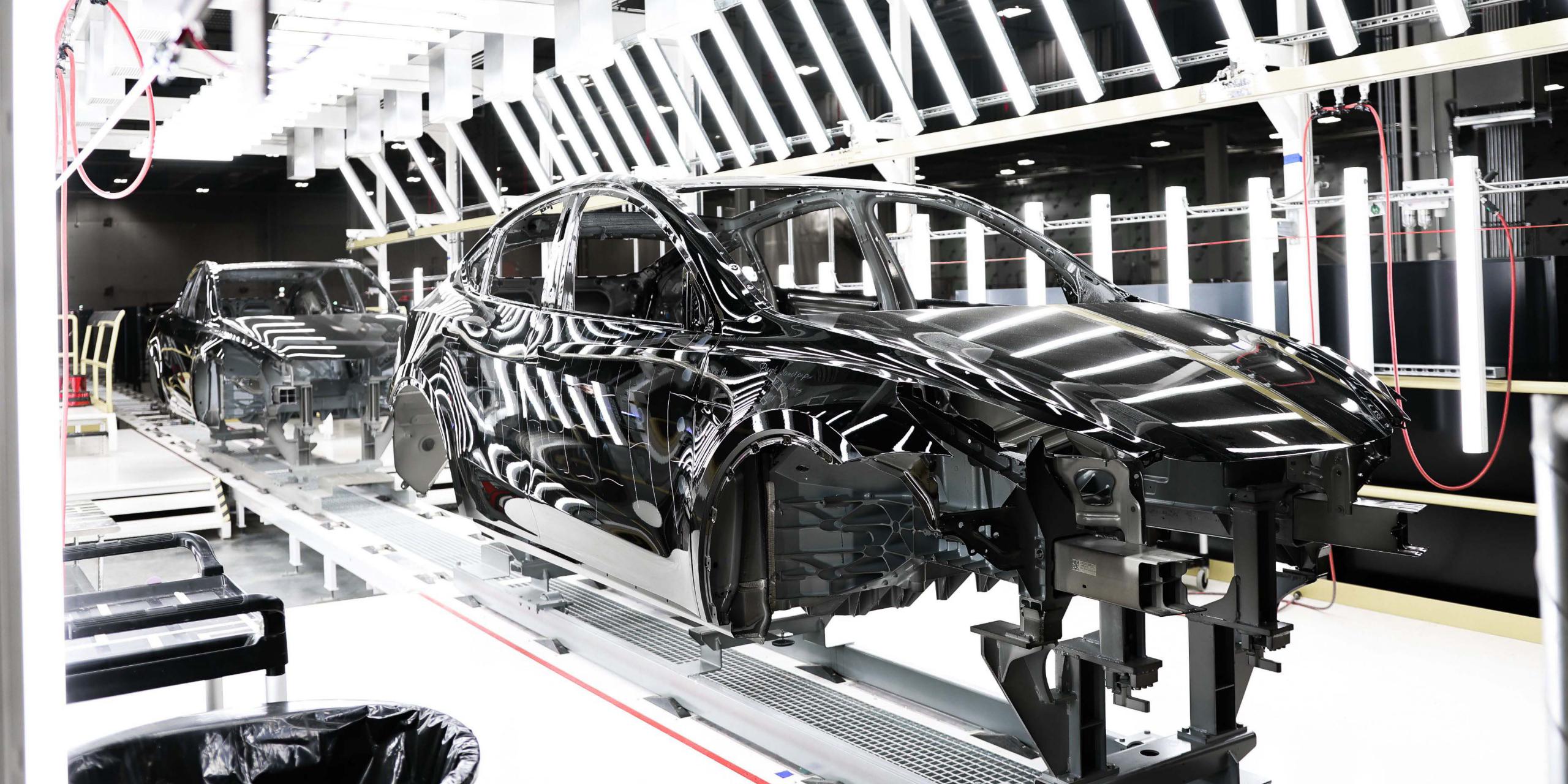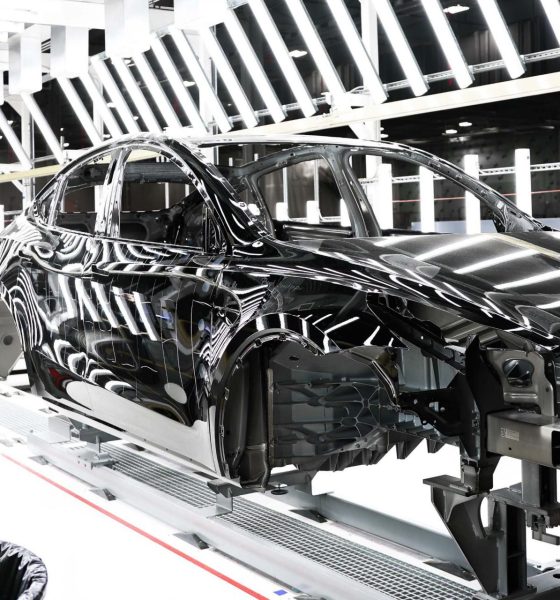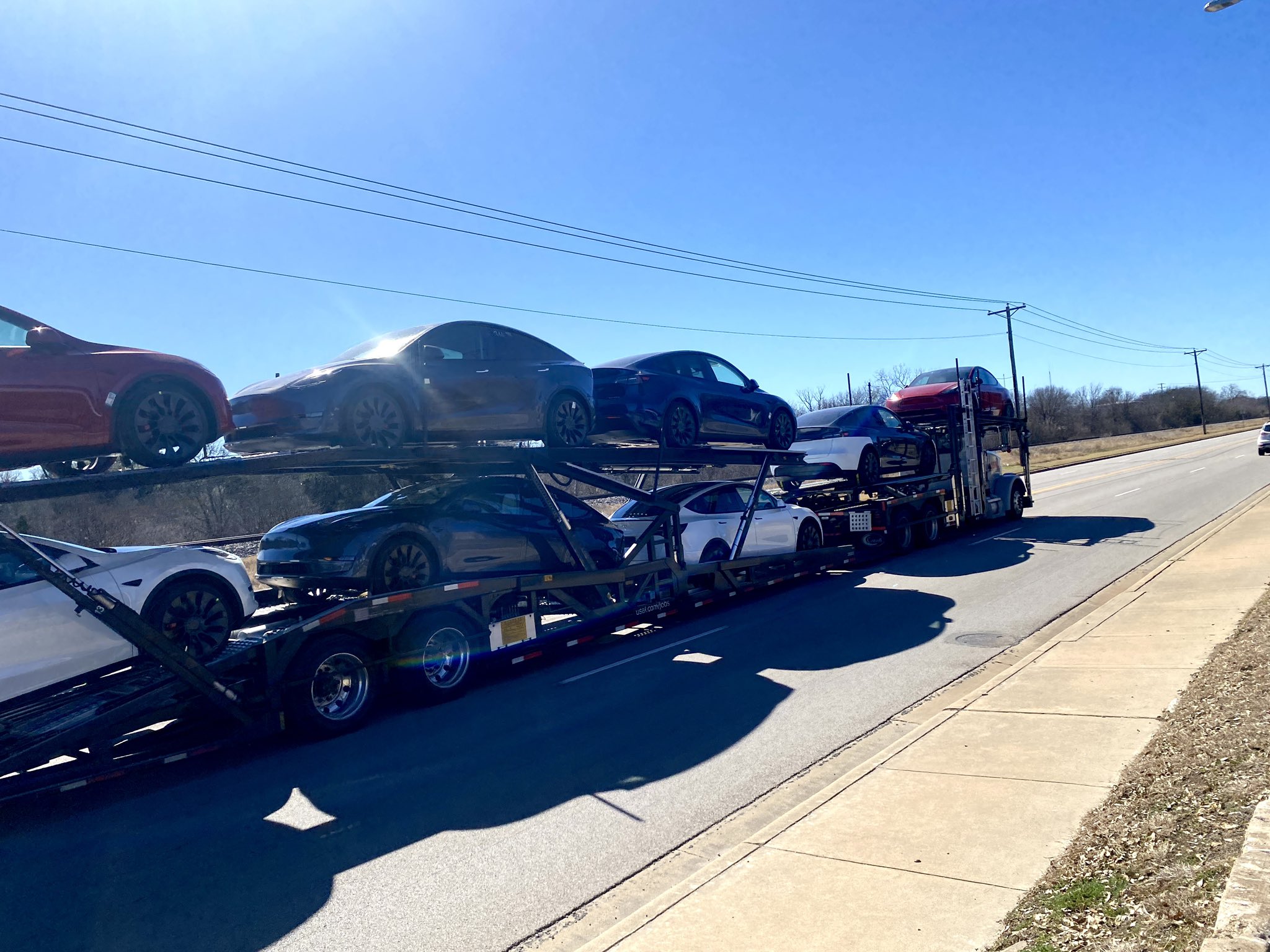

News
Tesla Model Y from Giga Texas is just one EPA approval away from first deliveries
Hundreds of Tesla Model Y all-electric crossovers have been spotted in the lots of Gigafactory Texas in the past few weeks, with some being spotted on haulers to be driven to destinations not known. However, haulers will likely be back soon for another logistics mission: to pick up the “Austin-made” Model Ys and take them to customers for delivery.
Tesla will be able to begin delivering units of its Austin-made Model Y all-electric crossover from Gigafactory Texas following the EPA approval of the vehicle, the agency told Teslarati. Currently, the Model Y from Gigafactory Texas is being produced with Tesla’s newest 4680 battery cells and new structural battery pack, has not gained its Certificate of Conformity, a document needed for a vehicle to be introduced into commerce.
Certificates of Conformity are effectively approval by the EPA that a vehicle can enter the stream of commerce. If it is introduced into commerce, the vehicle must have a Certificate of Conformity. The certifications are valid for a single model year, and new model year vehicles make their way to the EPA’s testing facility in Ann Arbor, Michigan every year to confirm they align with the EPA’s emissions standards.
“Prior to offering a vehicle for sale, all carlines in the Light-duty sector must be certified and Fuel Economy test data representing each model type must be submitted to EPA,” the EPA said to Teslarati in a statement. “EPA can confirm that Tesla has received a Certificate of Conformity for the 2022 Model Y Long Range AWD, Model Y Performance AWD (Test Group NTSLV00.0L2Y) and a Certificate for the Model Y RWD (Test Group NTSLV00.0L1Y).” These test groups were certified by the EPA last year, with the 2022 Model Y Long Range AWD and Performance variants gaining their Certificate of Conformity on November 1, 2021. It does not expire until December 31, 2022. The 2022 Model Y RWD, which is the variant that Tesla ultimately did not sell, gained its Certificate of Conformity from the EPA on September 28.
(Credit: Jeff Roberts)
Tesla’s Model Y made in Austin will also be a 2022 Model Y, which would mean it would technically align with the EPA’s Certificates of Conformity, especially as the geographic location of manufacture does not determine whether a vehicle conforms to the EPA’s standards or not. “EPA does not use the build location as a descriptor for a new test group or Certificate of Conformity,” the agency said. Instead, updates in the vehicle’s battery pack can prompt the EPA to consider certifying a vehicle again, even if the changes occur to a car in the same model year. However, the changes made to the vehicle prompted the EPA to certify the Austin-made Model Y separately.
In its 2017 document titled, “EPA Test Procedures for Electric Vehicles and Plug-in Hybrids,” the agency says that Confirmatory Testing for vehicles with the same model year is determined on a case-by-case basis, and the EPA can make a choice to certify a vehicle based on the changes:
“Currently, EPA performs confirmatory testing on all new light-duty electric vehicles and plug-in hybrid vehicles at EPA’s emission testing laboratory in Ann Arbor Michigan. If the manufacturer makes changes to an EV or PHEV that was previously tested at EPA, EPA will decide on a case-by-case basis whether additional EPA confirmatory testing is needed.”
What were the changes Tesla made exactly? The EPA confirmed to us that it could not comment on the status “of preproduction vehicles that are pending new emissions certification until manufacturers introduce them into commerce,” which means the Model Y’s changes are confidential until the car earns its Certificate of Conformity. Tesla did not respond to our inquiries to clarify why the vehicle needed to go through the EPA’s conformity procedure once again. However, Tesla’s most recent Earnings Call provided plenty of color to what the changes that prompted a new certification process likely are, and it has to do with Tesla’s 4680 battery cell.
The Battery Pack likely required the EPA to certify the Model Y once again
During the Q4 2021 Earnings Call, Tesla said that “after final certification of Austin-made Model Y, we plan to start deliveries to customers.” Additionally, during the Earnings Call CEO Elon Musk stated that Tesla was “building the Model Ys with the structural battery pack and the 4680 cells, and we’ll start delivering after final certification of the vehicle, which should be fairly soon.” Read More.
Previous builds of the Model Y, even 2022 model year vehicles, which were built at the Fremont Factory, have not yet used Tesla’s 4680 battery pack or the structural battery pack. Instead, Model Ys built at Fremont in the United States have used the automaker’s previous cell chemistry, the 2170 cell. When the EPA certified Tesla’s 2022 model year vehicles in August 2021, the certifications were for the previous battery pack. Read More.
Tesla Model Y from Giga Texas will equip Structural Battery Pack, 4680 cells
The 4680 batteries differ significantly from the 2170 cell in power, range, and efficiency. Therefore, the Model Y from Texas will have ratings that are substantially different from previous builds from Fremont. The Model Y from Austin needs eMPG ratings for FuelEconomy.gov and Monroney stickers.
Once Tesla is granted a Certificate of Conformity for Model Ys that are set to be produced at Gigafactory Texas, the automaker will be able to deliver the vehicles to customers.
Documents obtained by Teslarati show Tesla’s application to have the Model Y’s AWD and Performance variants certified together, while the RWD build of the car was certified separately. The documents state that each variant of the car conformed with California Air and Resource Board (CARB) standards, as well as Federal Emissions Standards that States which do not align with the CARB standards utilize. Texas withdrew its intentions to adopt CARB standards in 2007, State documents revealed.
States that have adopted CARB standards are New York, Massachusetts, Vermont, Maine, Pennsylvania, Connecticut, Rhode Island, Washington, Oregon, New Jersey, Maryland, Delaware, and most recently, Colorado, which adopted the standards this year.
How long until the Tesla Model Y from Gigafactory Texas is approved by the EPA?
The EPA cannot predict the timing of the certification process, and it varies from vehicle to vehicle. Rough timeframes are available by determining when Tesla submitted an application for a vehicle and when the vehicle gained its Certificate of Conformity.
Tesla’s application for the 2022 Model Y Long Range AWD and Performance variants is dated for October 21, while the Certificate of Conformity is dated November 1. However, this vehicle had a previous model year and utilized the same battery pack. The timeframe may be quicker as the 4680 pack has not been previously tested by the EPA for a passenger vehicle.
When Tesla submitted its application for the 2021 Model Y, it was the first certification process for the vehicle. Tesla submitted the application on December 13, 2019, with the Model Y gaining its Certificate of Conformity about a month later on January 8.
If Tesla submitted its application for the new Model Y on January 26 when it announced it was awaiting certification, deliveries could be approved within the coming days.
4680 Battery Cell
In September 2020, Tesla held “Battery Day” to unveil a new cell and manufacturing design that would increase vehicle safety and structural integrity. Musk unveiled the 4680 cell, a new electric vehicle battery capable of more range, power, and performance while offering a longer life cycle. Tesla has been producing the cell in volume at a facility known as Kato Road near the company’s Fremont factory in Northern California. Until now, no customer has driven a Tesla vehicle equipping the 4680 cell. The Model Y built at the Texas factory will be the first Tesla vehicle to utilize the new 4680 battery pack. Read More.
The vehicle will also utilize Tesla’s structural battery pack, the automaker confirmed. The structural battery pack uses engineering similar to an aircraft wing to use negative mass to increase structural integrity and density. The packs will also use a structural adhesive and flame retardant, attaching cells to the floor and ceiling of the pack, increasing stiffness and preventing major deformation in the event of a crash. Read More.
I’d love to hear from you! If you have any comments, concerns, or questions, please email me at joey@teslarati.com. You can also reach me on Twitter @KlenderJoey, or if you have news tips, you can email us at tips@teslarati.com.

News
Man credits Grok AI with saving his life after ER missed near-ruptured appendix
The AI flagged some of the man’s symptoms and urged him to return to the ER immediately and demand a CT scan.

A 49-year-old man has stated that xAI’s Grok ended up saving his life when the large language model identified a near-ruptured appendix that his first ER visit dismissed as acid reflux.
After being sent home from the ER, the man asked Grok to analyze his symptoms. The AI flagged some of the man’s symptoms and urged him to return immediately and demand a CT scan. The scan confirmed that something far worse than acid reflux was indeed going on.
Grok spotted what a doctor missed
In a post on Reddit, u/Tykjen noted that for 24 hours straight, he had a constant “razor-blade-level” abdominal pain that forced him into a fetal position. He had no fever or visible signs. He went to the ER, where a doctor pressed his soft belly, prescribed acid blockers, and sent him home.
The acid blockers didn’t work, and the man’s pain remained intense. He then decided to open a year-long chat he had with Grok and listed every detail that he was experiencing. The AI responded quickly. “Grok immediately flagged perforated ulcer or atypical appendicitis, told me the exact red-flag pattern I was describing, and basically said “go back right now and ask for a CT,” the man wrote in his post.
He copied Grok’s reasoning, returned to the ER, and insisted on the scan. The CT scan ultimately showed an inflamed appendix on the verge of rupture. Six hours later, the appendix was out. The man said the pain has completely vanished, and he woke up laughing under anesthesia. He was discharged the next day.
How a late-night conversation with Grok got me to demand the CT scan that saved my life from a ruptured appendix (December 2025)
byu/Tykjen ingrok
AI doctors could very well be welcomed
In the replies to his Reddit post, u/Tykjen further explained that he specifically avoided telling doctors that Grok, an AI, suggested he get a CT scan. “I did not tell them on the second visit that Grok recommended the CT scan. I had to lie. I told them my sister who’s a nurse told me to ask for the scan,” the man wrote.
One commenter noted that the use of AI in medicine will likely be welcomed, stating that “If AI could take doctors’ jobs one day, I will be happy. Doctors just don’t care anymore. It’s all a paycheck.” The Redditor replied with, “Sadly yes. That is what it felt like after the first visit. And the following night could have been my last.”
Elon Musk has been very optimistic about the potential of robots like Tesla Optimus in the medical field. Provided that they are able to achieve human-level articulation in their hands, and Tesla is able to bring down their cost through mass manufacturing, the era of AI-powered medical care could very well be closer than expected.
News
Tesla expands Model 3 lineup in Europe with most affordable variant yet
The Model 3 Standard still delivers more than 300 miles of range, potentially making it an attractive option for budget-conscious buyers.

Tesla has introduced a lower-priced Model 3 variant in Europe, expanding the lineup just two months after the vehicle’s U.S. debut. The Model 3 Standard still delivers more than 300 miles (480 km) of range, potentially making it an attractive option for budget-conscious buyers.
Tesla’s pricing strategy
The Model 3 Standard arrives as Tesla contends with declining registrations in several countries across Europe, where sales have not fully offset shifting consumer preferences. Many buyers have turned to options such as Volkswagen’s ID.3 and BYD’s Atto 3, both of which have benefited from aggressive pricing.
By removing select premium finishes and features, Tesla positioned the new Model 3 Standard as an “ultra-low cost of ownership” option of its all-electric sedan. Pricing comes in at €37,970 in Germany, NOK 330,056 in Norway, and SEK 449,990 in Sweden, depending on market. This places the Model 3 Standard well below the “premium” Model 3 trim, which starts at €45,970 in Germany.
Deliveries for the Standard model are expected to begin in the first quarter of 2026, giving Tesla an entry-level foothold in a segment that’s increasingly defined by sub-€40,000 offerings.
Tesla’s affordable vehicle push
The low-cost Model 3 follows October’s launch of a similarly positioned Model Y variant, signaling a broader shift in Tesla’s product strategy. While CEO Elon Musk has moved the company toward AI-driven initiatives such as robotaxis and humanoid robots, lower-priced vehicles remain necessary to support the company’s revenue in the near term.
Reports have indicated that Tesla previously abandoned plans for an all-new $25,000 EV, with the company opting to create cheaper versions of existing platforms instead. Analysts have flagged possible cannibalization of higher-margin models, but the move aims to counter an influx of aggressively priced entrants from China and Europe, many of which sell below $30,000. With the new Model 3 Standard, Tesla is reinforcing its volume strategy in Europe’s increasingly competitive EV landscape.
News
Tesla FSD (Supervised) stuns Germany’s biggest car magazine
FSD Supervised recognized construction zones, braked early for pedestrians, and yielded politely on narrow streets.

Tesla’s upcoming FSD Supervised system, set for a European debut pending regulatory approval, is showing notably refined behavior in real-world testing, including construction zones, pedestrian detection, and lane changes, as per a recent demonstration ride in Berlin.
While the system still required driver oversight, its smooth braking, steering, and decision-making illustrated how far Tesla’s driver-assistance technology has advanced ahead of a potential 2026 rollout.
FSD’s maturity in dense city driving
During the Berlin test ride with Auto Bild, Germany’s largest automotive publication, a Tesla Model 3 running FSD handled complex traffic with minimal intervention, autonomously managing braking, acceleration, steering, and overtaking up to 140 km/h. It recognized construction zones, braked early for pedestrians, and yielded politely on narrow streets.
Only one manual override was required when the system misread a converted one-way route, an example, Tesla stated, of the continuous learning baked into its vision-based architecture.
Robin Hornig of Auto Bild summed up his experience with FSD Supervised with a glowing review of the system. As per the reporter, FSD Supervised already exceeds humans with its all-around vision. “Tesla FSD Supervised sees more than I do. It doesn’t get distracted and never gets tired. I like to think I’m a good driver, but I can’t match this system’s all-around vision. It’s at its best when both work together: my experience and the Tesla’s constant attention,” the journalist wrote.
Tesla FSD in Europe
FSD Supervised is still a driver-assistance system rather than autonomous driving. Still, Auto Bild noted that Tesla’s 360-degree camera suite, constant monitoring, and high computing power mark a sizable leap from earlier iterations. Already active in the U.S., China, and several other regions, the system is currently navigating Europe’s approval pipeline. Tesla has applied for an exemption in the Netherlands, aiming to launch the feature through a free software update as early as February 2026.
What Tesla demonstrated in Berlin mirrors capabilities already common in China and the U.S., where rival automakers have rolled out hands-free or city-navigation systems. Europe, however, remains behind due to a stricter certification environment, though Tesla is currently hard at work pushing for FSD Supervised’s approval in several countries in the region.








